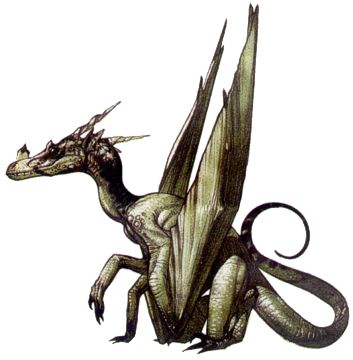

Dragon #272

| Climate/Terrain: | Coastal waters |
|---|---|
| Frequency: | Rare |
| Organization: | Flock |
| Activity Cycle: | Day |
| Diet: | Fish |
| Intelligence: | Average (8-10) |
| Treasure: | R |
| Alignment: | Chaotic good |
| No. Appearing: | 2-20 |
| Armor Class: | 6 |
| Movement: | 3, fly 24 (B), swim 9 |
| Hit Dice: | 1+2 |
| THAC0: | 19 |
| No. of Attacks: | 1 |
| Damage/Attack: | 1-6 |
| Special Attacks: | Dive |
| Special Defenses: | Fog cloud |
| Magic Resistance: | 15% |
| Size: | T (2’ long) |
| Morale: | Average (8) |
| XP Value: | 270 |
These coastal dragonets are known for their habit of following ships to feed on the fish disturbed by the vessel’s passing, much like sea gulls. This has earned them their name, as they tend to swoop around the crow’s nest of a ship and sometimes perch on it. They occasionally take seafaring wizards or other sailors as companions, becoming a familiar or henchman to such characters.
Crow’s-nest dragons are small reptiles very similar in appearance to pseudodragons, though they lack that creature’s poisonous stinger. Their scales are iridescent white, like pearls, and their tails are as long as their snakelike bodies, reaching out an additional 2’ behind them. Their wings are long and wide, resembling a pelican’s, but they fold them close to their bodies when diving for fish.
Combat: The crow’s-nest dragon has large, powerful jaws with which it can inflict a fierce bite. They ordinarily swallow fish in one gulp, but a flock sometimes cooperates to kill larger fish such as tuna or even swordfish. Their favorite tactic is to dive from a great height onto their prey, attacking with a +4 bonus and inflicting double damage with their bite. Their small front claws are useless in combat, though a dragonet can pick up and manipulate small objects with them.
When threatened, crow’s-nest dragons usually fly away. If pursued by a flying predator, however, they might use their ability to breathe out a fog cloud as a 9th-level caster. Although the cloud usually blows away quickly in the ocean winds, it can give the dragonets time to escape. Each dragonet can use this magical breath only once per day.
Crow’s-nest dragons are speedy flyers an can swim fairly quickly at the end of their dives. They cannot breathe water but can remain underwater for up to 10 minutes in pursuit of prey.
Habitat/Society: Crow’s-nest dragons occasionally respond to find familiar spells cast at sea or otherwise attach themselves to scouts for sailors, as they can transmit their bird’s-eye view via telepathy to a single companion within 240 yards. Otherwise, their telepathic communication is limited to empathy, for unlike pseudodragons, crow’s-nest dragons cannot transmit sound to their companions. Their vocal range is more limited than the vocal range of pseudodragons; they can only chirp in varying tones to make their wishes known.
Crow’s-nest dragons tend to be loyal to their companions, though they are more flighty and chaotic than pseudodragons. They do not require as much pampering but are prone to mischief even when treated well. Their curiosity is insatiable, and sailors say their hunger is as well.
Ecology: Crow’s-nest dragons build nests near the tops of rugged sea cliffs among the rocks. They mate for life, and a pair shares the responsibility of rearing the clutch of 3-5 young. They eat fish and cephalopods, but favor cuttlefish and squid. Large marine predators such as sharks or whales and aerial hunters like giant eagles or manticores are natural enemies.
Sailors consider crow’s-nest dragons a sign of good fortune, and indeed some magical power seems to bestow protection on a ship when these dragonets are near. If a flock of crow’s-nest dragons travels with a ship, the vessel’s seaworthiness rating is increased by 15%, reflecting the fortunate influence of the dragonets. If someone aboard a ship kills a crow’s-nest dragon, the flock departs immediately, never to return.
Crow’s-nest dragons have a natural lifespan of 11-20 years.
